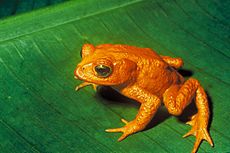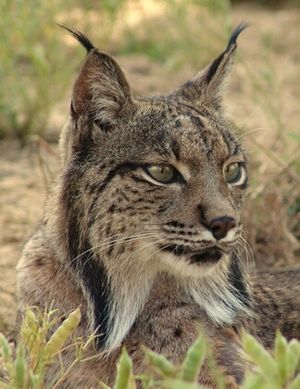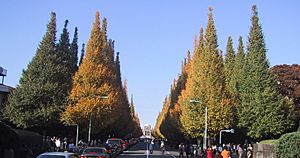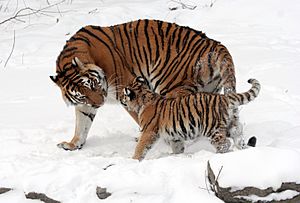Endangered species (IUCN status) facts for kids
Quick facts for kids Conservation status
|
|
|---|---|
 |
|
| Extinct | |
|
|
| Threatened | |
|
|
| Lower Risk | |
|
|
|
Other categories |
|
|
|
|
Related topics
|
|
 Comparison of Red list classes above and NatureServe status below  |
|

Endangered species are types of species (like animals or plants) that are very likely to disappear from the wild soon. This classification is made by a group called the International Union for Conservation of Nature (IUCN). They keep a special list called the IUCN Red List.
Being "endangered" is the second most serious warning on this list. It means a species is in great danger. Even more serious is "critically endangered". In 2012, the IUCN Red List showed that over 3,000 animal species and 2,600 plant species were endangered worldwide. These numbers have increased a lot over the years.
Contents
What is the IUCN Red List?
The IUCN Red List is like a global report card for nature. It helps us understand how healthy different species populations are. Experts check each species and give it a "conservation status." This status tells us how much danger a species is in.
Some species might be "Least Concern" (LC). This means they have strong and healthy populations. Others might be "Near Threatened" (NT), meaning they could be at risk soon.
Species that are "Endangered" (EN) are in the middle of the threatened categories. They are more at risk than "Vulnerable" (VU) species but not as much as "Critically Endangered" (CR) ones. Sometimes, there isn't enough information about a species. Then, it's called "Data Deficient" (DD).
The word "threatened" is a general term. It includes all species that are Vulnerable, Endangered, or Critically Endangered. It's important to remember that the IUCN uses these terms in a very specific way.
Here are some examples of species currently listed as endangered by the IUCN:
As scientists learn more, or as the rules change, some species might be re-evaluated. Even so, the total number of endangered species keeps growing. This is because new species are assessed every year.
How a Species Becomes Endangered
A species is listed as endangered if it meets certain rules set by the IUCN. These rules look at different factors that show a species is in trouble.
Population Decline
One main reason is a big drop in the number of individuals in a species. For example, if a species' population has shrunk by 50% or more over 10 years, it might be listed as endangered. This decline can be due to many things. It could be from losing their homes, too much hunting, or new diseases. Sometimes, the reasons for the decline are not fully understood.
Small Geographic Range
Another factor is how much space a species lives in. If a species lives in a very small area, it's more at risk. For example, if its entire habitat is less than 5,000 square kilometers (about 1,900 square miles), it could be endangered. This is especially true if their habitat is broken up into tiny pieces. A small area means they are more vulnerable to sudden changes.
Very Few Individuals Left
A species can also be endangered if there are very few adult individuals left. If there are fewer than 2,500 mature individuals, and their numbers are still falling, they are in serious trouble. This is even worse if most of these individuals are found in just one small group.
High Risk of Extinction
Finally, if scientific analysis shows a high chance of a species dying out, it will be listed as endangered. This means there's at least a 20% chance of the species becoming extinct in the wild within 20 years. Scientists use special computer models to figure out these risks.
See also
- Lists of IUCN Red List endangered species
- List of endangered amphibians
- List of endangered arthropods
- List of endangered birds
- List of endangered fishes
- List of endangered insects
- List of endangered invertebrates
- List of endangered mammals
- List of endangered molluscs
- List of endangered reptiles
- List of Chromista by conservation status
- List of fungi by conservation status



